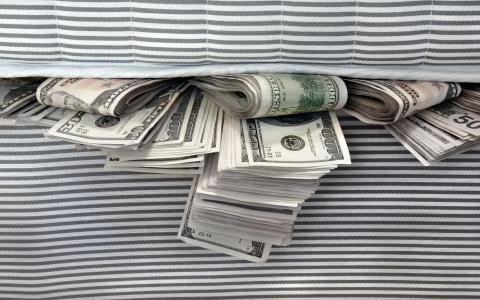
(Forbes) Stocks have recovered from last fall’s crash, low interest rates stretch out to the horizon and the VIX volatility index is half what it was at Christmas. Sit back and coast to a comfortable retirement.
No, don’t, says Nancy Davis. This veteran derivatives trader runs Quadratic Capital Management, where her somewhat contrarian view is that investors, all too complacent, are in particular need of insurance against financial trouble.
The Quadratic Interest Rate Volatility & Inflation Hedge ETF, ticker IVOL, is designed to provide shelter from both inflation and recession. Its actively managed portfolio mixes inflation-protected Treasury bonds with bets, in the form of call options, on the steepness of the yield curve.
Those options are cheap, for two reasons. One is that, at the moment, there is no steepness: Yields on ten-year bonds are scarcely higher than yields on two-year bonds. The other is that the bond market is strangely quiet. Low volatility makes for low option prices.
“Volatility has been squashed by central bank money printing,” Davis says, before delving deep into the thicket of option mathematics. If volatility in interest rates rebounds to a normal level, her calls will become more valuable. Alternatively, she would get a payoff if the yield curve tilts upward, which it has a habit of doing when inflation surges, stocks crash or real estate is weak.
If IVOL is all about peace of mind for the investor, it’s all about risk for its inventor. Davis, 43, has poured her heart, soul and net worth into Quadratic, of which she is the founder and 60% owner. If the three-month-old exchange-traded fund takes off, she could become wealthy. If it doesn’t, Quadratic will struggle.
The fund showed its worth in the first week of August, climbing 2% as the stock market sank 3%. But it needs a much bigger shock to stock or bond prices in order to get big. It has gathered only $58 million so far. A crash had better arrive soon; IVOL’s call options expire next summer. Quadratic, moreover, needs to somehow scale up without inspiring knockoff products from ETF giants like BlackRock.
Davis was a precocious trader. As an undergraduate at George Washington University, she took grad courses in financial markets while earning money doing economic research for a consulting firm. She put some of her paychecks into a brokerage account. “Some women love to buy shoes,” she says. “I love to buy options.”
This was in the 1990s, a good time to indulge a taste for calls. Davis made out-of-the-money bets on technology stocks, which paid off well enough to cover the down payment, in 1999, on a New York City apartment. Nice timing.
There may be a sour grape, but there’s also truth in her current philosophy that hedge funds are not such a great deal for investors. ETFs, she says, are more liquid, more transparent and cheaper.
Davis spent a decade at Goldman Sachs, most of it on the firm’s proprietary trading desk, then did a stint at a hedge fund. At 31 she quit to actively manage two kids. Returning to Wall Street after a three-year hiatus, she worked for AllianceBernstein and then did what few women do, especially women with children: She started a hedge fund.
Quadratic, whose assets once topped $400 million, used a hedge fund platform at Cowen & Co. When Cowen ended the partnership last year, Davis set about reinventing her firm. There may be a sour grape, but there’s also truth in her current philosophy that hedge funds are not such a great deal for investors. ETFs, she says, are more liquid, more transparent and cheaper.
IVOL’s 1% annual fee is stiff, but Davis says it’s justified for a fund that is not only actively managed but also invested in things that ordinary folk cannot buy. If you want to duplicate her position in the Constant Maturity Swap 2-10 call due July 17, you’d need to know what banker to ring for a quote, because this beast is not traded on any exchange. Each of these calls, recently worth $7.71, gives the holder the right to collect a dollar for every 0.01% beyond 0.37% in the spread between ten-year interest rates and two-year interest rates. The spread has to move a long way up before the option is even in the money. But at various times in the past the spread has hit 2%. Could it do that again? Maybe, at which point the option pays $163.
Starting a firm like Quadratic is like buying an out-of-the-money call: long odds, big payoff. Davis is doing what she was doing in college. You can’t stop a trader from trading.



